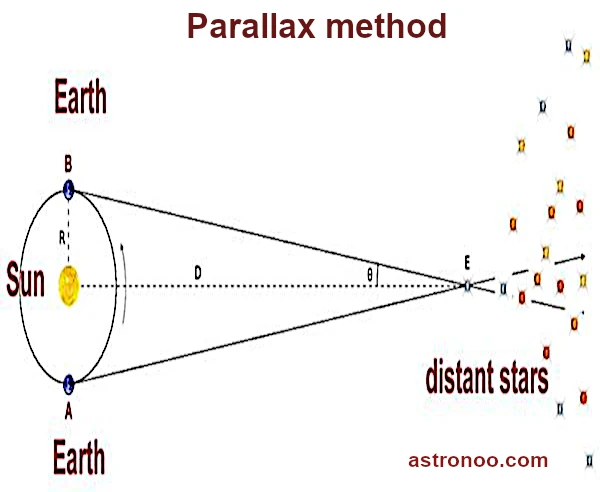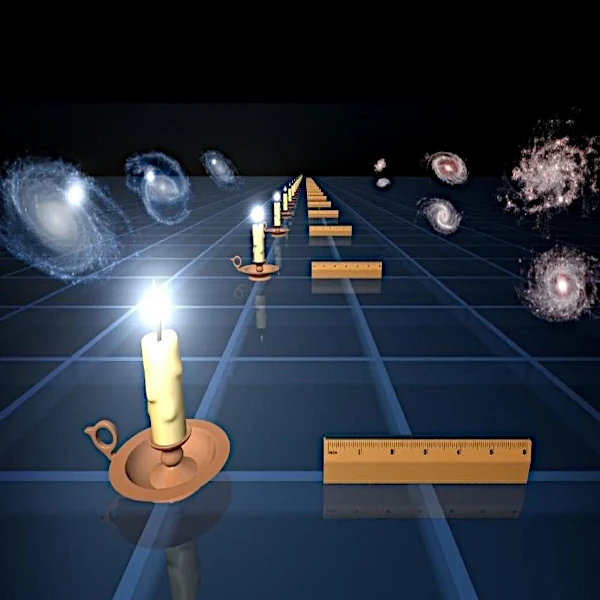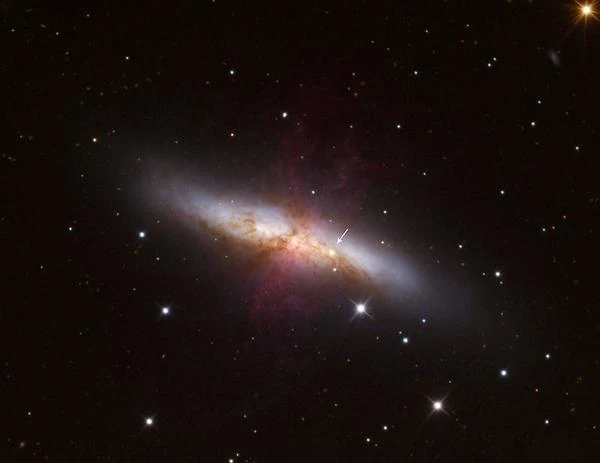
Image description: Annual parallax is used to estimate the distance to a star. Scientists measure the parallax angle by noting the position of a star against the celestial sphere, 6 months apart. To do this, one simply needs to measure from one position on Earth's orbit, and measure again 6 months later when Earth is on the opposite side of the Sun. The diameter of Earth's orbit is approximately 300 million km, and the parallax angle gives the distance through a simple trigonometric calculation.
Measuring distances in our vast observable Universe is fundamental in astrophysics as it becomes possible to estimate the intrinsic properties of the observed object. Unfortunately, obtaining high precision is very challenging. To measure the vast cosmic distances of the universe, astronomers use several calculation methods on increasingly distant objects. The measurement of a nearby object must be made with confidence because the methods are interlinked, and each measurement method calibrates the next.
The image of the world around us is reconstructed in real-time by our brain from two series of information.
Our two eyes are spaced a few centimeters apart, so the image received by each of these receptors is slightly different. Indeed, for the observed object, each eye provides a position relative to a more distant and stationary background. An object that does not have the same position relative to the background causes an optical effect known as the parallax effect. It is this effect that allows our brain to reconstruct a three-dimensional image in order to gauge the object's distance.
In astronomy, parallax is the angle under which the observed object is seen from two points distant from each other (the greater the distance between the observation points, the larger and easier to measure the parallax angle).
For solar system objects, the Earth's equatorial radius (6,378 km) has been chosen. Equatorial parallax is the angle under which an observer at the center of the observed object sees the Earth's radius.
This angle directly gives us the object's distance through a simple trigonometric calculation. For example, for an average distance to the Moon of 384,400 km, the lunar equatorial parallax is approximately 57' and the apparent diameter of the Moon is approximately 31', or about ½ degree.
To measure the distance of stars in our Galaxy, the reference is the semi-major axis of Earth's orbit (149,597,870,700 meters or 1 Astronomical Unit). To measure this annual parallax, it is enough to observe the star twice, six months apart. In other words, astronomers measure the annual parallax angle by measuring the position of a star once and then measuring again 6 months later when Earth is on the opposite side of its orbit. However, this is not easy to measure because the farther the star is from Earth, the smaller the parallax.
For example, for the closest star to the Sun, Proxima Centauri (Alpha Centauri C), located 4.244 light-years away, the parallax is only 0.7 arcseconds, which is minute—there are 360 degrees in a circle, each degree contains 60 arcminutes, and each minute contains 60 arcseconds. However, the precision of measurements from Earth only allows the measurement of a few stars located within a few tens of light-years.
From space, thanks to the Hipparcos satellite (HIgh Precision PARallax COllecting Satellite), we can measure the parallaxes of 120,000 stars with a precision of 2 to 4 milliarcseconds. In 2013, the Gaia satellite succeeded Hipparcos.
Gaia (Global Astrometric Interferometer for Astrophysics) established a catalog of one billion stars with a precision of up to 10 microarcseconds.

Image description: Cepheids with known luminosity become "standard candles" for measuring the distance to distant stars and nearby galaxies. The intrinsic luminosity of classical Cepheids increases with their blinking period. Credit NASA
For measuring the distance to very distant stars, the parallax method is no longer possible due to its imprecision. Astronomers use another method, that of "standard candles."
In the 1910s at Harvard University, Henrietta Leavitt (1868-1921) classified Cepheids in the Magellanic Clouds (two dwarf galaxies neighboring the Milky Way located between 150 and 200 light-years away). A Cepheid is a star whose brightness varies over a well-defined period (between 1 and 135 days). It was in 1908 that the first standard candle was unexpectedly discovered, thanks to Henrietta Leavitt's intuition. She noticed that the periods of Cepheids are longer the brighter they are. The intrinsic luminosity of classical Cepheids thus increases with their period. In other words, the larger and brighter a Cepheid is, the slower its pulsation frequency. She found a relationship linking the variation period (time between two maxima or minima) to the apparent brightness of these stars.
Thus, measuring the precise distance of one of these Cepheids using the parallax method provides a general relationship between the periods and absolute luminosities of Cepheids.
This measurement was first made in 1916 at Harvard University by Harlow Shapley (1885-1972), who completed Henrietta Leavitt's discovery. From that date, Cepheids with known intrinsic luminosity became "standard candles" for measuring the distance to distant stars and nearby galaxies.
The apparent brightness of an object thus depends on its absolute luminosity and distance. It was by observing variable stars of the Cepheid type that astronomer Edwin Hubble (1889-1953) measured in 1923 the distance to the spiral galaxy M31 (Andromeda, the closest to the Milky Way), using the telescope at Mount Wilson Observatory, near Pasadena, California.

Image description: Supernova SN 2014J in the Cigar Galaxy (M82). The explosion of the star is shown by the arrow, in the right part of this galaxy notable for its bright blue disk. Bright Supernova in M82 Image Credit: Adam Block, Mt. Lemmon SkyCenter, U. Arizona.
For distant galaxies, telescopes can no longer distinguish their stars individually. Astronomers must rely on extremely bright objects, as bright as a galaxy. The object used is the Type 1a supernova.
Supernovae are rare events in our Milky Way, occurring once to three times per century; however, on the scale of the universe, they are observed every day.
A Type 1a supernova corresponds to the complete explosion of a white dwarf that has surpassed the Chandrasekhar limit (when the radius of the star decreases, the mass approaches a limit of 1.44 solar masses). Due to their physical properties, white dwarfs fueled by material from a nearby companion cannot exceed this limit.
The Type 1a supernova SN 2014J is located in the Cigar Galaxy (Messier 82) at 11.5 ± 0.8 million light-years.
This cosmological standard candle will allow for the determination of extragalactic distances.
Because they always explode at the same point (the mass limit), Type 1a supernovae have approximately the same intrinsic luminosity after reaching their maximum brightness. Type 1a supernovae, being very bright and visible at great distances, therefore serve as standard candles.
To calibrate the method, it is necessary to use Type 1a supernovae that are close enough to be measured using the Cepheid method. Scientists know of a few dozen Type 1a supernovae that are sufficiently close.
Type 1a supernovae will enable the measurement of distances to distant galaxies up to several billion light-years away.

Description of the image: Absorption spectral lines in the optical spectrum of a distant galaxy cluster (top panel) compared to a nearby object, the Sun (bottom panel). The arrows indicate the redshift or increase in wavelength to lower energy. Credit: Georg Wiora
For even more distant galaxies, astronomers use the redshift method of absorption lines in the electromagnetic spectrum.
This redshift measures the duration of the light's journey. The older the light, the greater the redshift.
Each chemical element or molecule leaves different traces on this spectrum. These traces appear at very specific wavelengths (absorption lines). But if a galaxy is moving away from us, its light stretches, and the wavelengths of these chemical fingerprints shift towards the red. This shift is related to the distance of the galaxy by Hubble's law. This law states that the farther a galaxy is, the faster it is moving away from us as the universe expands. By measuring the redshift, astronomers have been able to identify some of the earliest galaxies near the Big Bang.
Thus, light reveals the distance of both nearby and distant cosmic objects, and astronomers today can measure distances to the farthest reaches of the observable universe (about 13 billion light-years).
Note: Redshift is a shift towards longer wavelengths in the spectral lines and the entire visible spectrum. There is a correlation between distance and the redshift of the optical spectra of galaxies. Redshift is the most commonly used method to measure the distance of extragalactic objects. This phenomenon observed in the light of distant astronomical objects is evidence of the expansion of the universe (spatial dilation) and the Big Bang.